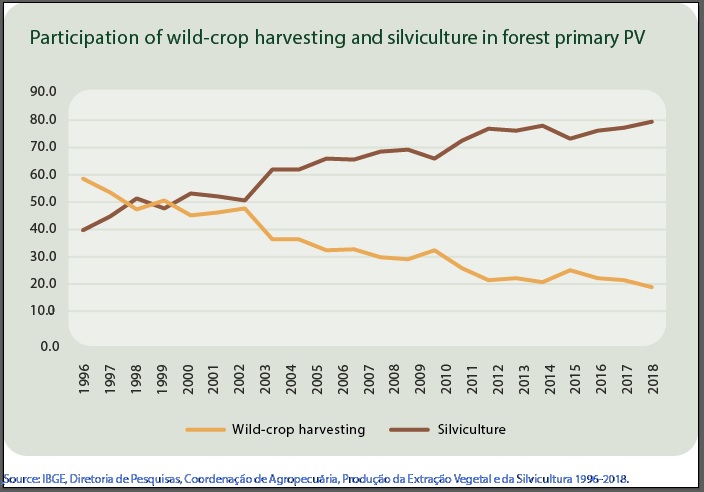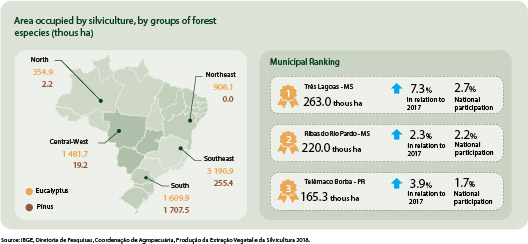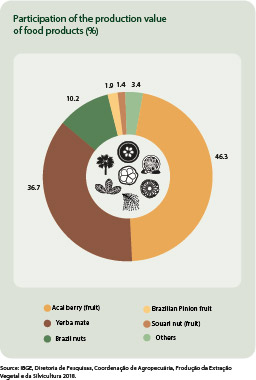PEVS 2018: silviculture and wild-crop harvesting reach R$20.6 billion and grow 8.0% over 2017
September 19, 2019 10h00 AM | Last Updated: September 30, 2019 11h32 AM
The value of silvicullture and wild-crop harvesting amounted to R$ 20.6 billion in 2018, recording an increase (the third consecutive) of 8.0% in relation to 2017.
Silviculture (production from planted forests) participated with 79.3% (R$16.3 billion) to this total, representing an increase of 11.1% in the production value compared to 2017. Wild-crop harvesting (production from native woods and forests) accounted for 20.7% (R$ 4.3 billion) and edged down 2.7% (the third consecutive drop) in relation to the previous year.
In silviculture, the production of wood for the pulp and paper industry added up the biggest value in production in 2018 (R$ 5.1 billion). However, the major influence for the growth in the production value of silviculture was the charcoal production, with an increase of 18.9%, accounting for the value of R$4.1 billion (an increase of 50.5% in the production value).
Also regarding silviculture, Minas Gerais recorded the biggest value in production (R$ 4.6 billion, a growth of 45.7%), surpassing Paraná (R$ 3.1 billion). Mato Grosso do Sul achieved the top position as the major national producer of wood for the pulp and paper industry, with a growth of 36.2%. Among Brazilian municipalities, Telêmaco Borba – PR recorded the biggest value in the production of silviculture, with R$326.9 million, followed by Três Lagoas – MS, with R$280.5 million. Both are pulp producers. The planted forest area expanded 1.3% in the country, an increase of 131.8 thousand hectares of land, mainly concentrated in the Southeast and South Regions (70.1%).

In wild-crop harvesting, the wood product, which represented 62.1% of production value, recorded a rebound of 5.2% in the year. Logwood – the major influence in the production value of the group – retreated 4.9% in production and, as consequence, edged down 3.7% in the production value.
The non-wood products recorded a growth of 1.8% in the production value, accounting for R$1.6 billion. Among these products, acai berry remains recording the biggest value in production (R$ 592.0 million), an increase of 2.5% compared to 2017. The Brazil nut output grew again in 2018, after two consecutive years of decrease. The growth was of 46.3% in the volume and 35.4% in the production value.
The information is from the Forestry Activities Survey (PEVS) 2018, which monitors 37 products from wild-crop harvesting and seven from silviculture in all Brazilian municipalities. The survey presents information about output, changes and spatial distribution of wood products and non-wood products. Furthermore, it indicates the contribution of wild-crop harvesting and silviculture in the value of forestry production. The support material for this survey can be found on the right of the page.
Silviculture increases 11.1% stimulated by charcoal production
Silviculture recorded growth for the third consecutive year and achieved R$16.3 billion in the production value. The major influence was the increase of 50.5% in the value of charcoal production, due, mainly, to the improvement in the performance of the steel industry in 2018 – sector with the highest consume of this product as energy source. The charcoal production increased 18.9% and its value of production achieved R$ 4.1 billion.
Wood production for the pulp and paper industry induced the biggest value in silviculture in 2018, contributing with 31.3% and recording R$5.1 billion (growth of 2.0%). The logwood production for pulp and paper increased 6.3%.
Occupying the second position in the silviculture value, logwood production for other purposes represented 28.2% of the total, accounting R$4.6 billion. The growth of 5.3% was influenced mainly by the increase in the prices of wood for sawmill and lamination market, with an increase of 4.4% in the output volume.
With the increase in charcoal consumption, the consumption of wood for power purposes retreated, a fall of 4.6% in the value of production and of 4.2% in the volume, adding up 52.6 million cubic meters in the year.
Regarding the group of non-wood products in silviculture, it recorded increases in the value of production. The resin, the most representative item in this group, even presenting a volume of production similar to that of the previous year, recorded a growth of 11.4% in the value of production, accounting R$362.3 million. São Paulo was responsible for 67.8% of the resin production in 2018.
Minas Gerais’s forestry boosts
Minas Gerais is the Federation Unit with the biggest value in forestry, with a rise of 44.8% and achieving R$4.7 billion, and contributes with 22.8% of the national total. This result exceeds Paraná, which recorded R$3.6 billion in the value of production. In silviculture, especifically, Minas Gerais occupies the first place, after the 45.7% growth and production value of the R$4.6 billion. Next, Paraná accounted for R$3.1 billion. The main influence in the growth in Minas Gerais was the increase in the production of charcoal.
With an estimated production of 13.1 million cubic meters (25.0% of national output), Rio Grande do Sul was a highlight in firewood from planted forests, surpassing Paraná, which edged down 3.1% in the volume of production. Minas Gerais’s value of production achieved R$555.0 million (increase of 0.6%), while Paraná recorded retreats of 8.0%, with R$547.0 million.
Leading the rank of municipalities, Telêmaco Borba, in Paraná, recorded the biggest value of production in silviculture, with R$ 326.9 million. The municipality is the national highlight in the production of pulp and paper, recording the increase of 54.9% in the volume of this product in the year. The Três Lagoas municipality, in Mato Grosso do Sul, which is located in other national industrial park of pulp, presented the second biggest production value in silviculture, with R$280.5 million. The other four municipalities of Minas Gerais (João Pinheiro, Itamarandiba, Curvelo and Três Marias), two of Paraná (General Carneiro and Cerro Azul) and two of Mato Grosso do Sul (Selvíria e Agua Clara) complete the 2018 top ten production value rank of municipalities in silviculture.
Mato Grosso do Sul records the biggest production of wood for pulp and paper
Mato Grosso do Sul was responsible for the major volume of logwood for pulp and paper, the most relevant product in the value of forestry production. With an increase of 36.2%, the estate produced 17.5 million cubic meters, which represents 18.9% of the national production. The expansion of power capacity of the local industrial park, one of the most concentrated in the world in terms of pulp production, influenced the upward trend in production of eucalyptus wood in the region, this volume increased more than twice in the last five years.
It is also in Mato Grosso do Sul that five of the ten municipalities with the largest national planted forest are located. The municipalities of Mato Grosso do Sul, Três Lagoas and Ribas do Rio do Pardo, leading the rank, with 263 thousand hectares and 220 thousand hectares, respectively, followed by Paraná’s municipalitiy, Telêmaco Borba, with 165 thousand hectares, all of them with eucalyptus predominance. The three municipalities are areas focused on pulp and paper production.

Planted forest areas grew 1.3%
The total area of planted forest grew 1.3%, reaching 9.9 million hectares, concentrated mainly in the Southeast and South Regions (70.1%). There was an extension of 131.8 thousand hectares, with 110.8 thousand of eucalyptus areas, which represents 76.2% of the total national area. Together, eucalyptus and pinus were responsible for 96.6% of the planted forests for industrial purposes. The eucalyptus areas added up 7.5 million hectares.
All groups of wood products indicated predominance of production based on eucalyptus wood in the national territory. In the pulp and paper industry, the eucalyptus is used as raw material for the production of short fiber pulp, whose products are mainly paper for printing, writing and sanitary purposes. Yet, the pinus wood is targeted at the production of long fiber pulp, whose products are high quality kinds of paper that request more resistence.
Comparing the regions, the Southeast recorded the major area extension, with additional 96.6 thousand hectares in the end of 2018; the South Region gathers the biggest planted area (35.2%).
Minas Gerais has been recording the biggest planted area in the country, exceeding the two million hectares (a growth of 3.3% in the year), with eucalyptus prevailing. Paraná has the second biggest planted area, 1.5 million hectares, of which 53.4% are destined for pinus.
Wild-crop harvesting records falls in major wood products
In 2018, the value of production from wild-crop harvesting retreated 2.7%, accounting for R$4.3 billion. The group of wood products, which had the biggest contribution to the value of wild-crop harvesting production (62.1%), recorded retreats of 5.2% in the year. Over the years, the wood harvesting was getting weaker and, slowly, being replaced by wood from planted forests.
Among the major wood products from wild-crop harvesting, the logwood, with the biggest contribution to the production value, recorded retreats of 4.9% in production, accounting for 11.6 million cubic meters. Consequently, it has decreased 3.7% in the production value, accounting for R$ 1.9 billion. Charcoal harvesting was the product in this group with the highest decrease in the volume of production (21.6%), accounting for 338.3 thousand in the year.
Food has increased 4.1%; acai berry is the major contribution in the Production Value
In 2018, the amount in the value of non-wood products recorded an increase of 1.8%, accounting R$1.6 billion. This kind of harvesting activity has great importance for the traditional population and communities, because it contributes to workforce hiring and income distribution.
The group of food products, the major among the non-wood products from wild-crop harvesting, recorded again an upward trend in the production value (4.1%), accounting for R$1.3 billion. The acai berry recorded the biggest contribution in the production value in this group (46.3%).
The Amazonian acai berry is harvested from a regional Palm tree, and it has 92.0% of its harvesting production centered in the Northern states. In 2018, the harvesting production of acai berry achieved 221,646 tonnes, a volume 0.9% higher than that of the previous period, stimulating the growth of 2.5% in the value of production (R$592.0 million). The production obtained by the harvesting activity was responsible for 12.8% of the total acai production in the country.
Pará recorded the biggest production, with 147.7 thousand tonnes, a volume 4.1% bigger than in the previous year. - In the rank of the municipalities that recorded the highest volume of production in 2018, 8 out of 10 are Pará’s municipalities, with Limoeiro do Ajuru in the highest position as a producer of acai berry, with 18.5% of national volume.
The yerba mate harvesting, concentrated in the South region, was responsible for the highest production value among the non-wood products, with R$468.4 million – a decrease of 0.8%. The production achieved 393,0 thousand tonnes, an increase of 2.4% against previous period. The ten municipalities with the biggest production in 2018 are from Paraná. São Matheus, again, was the municipality that recorded the biggest volume of yerba mate harvesting in the year, accounting for 17.8% of the national total.
It is worth highlighting that, nowadays, the biggest volume of acai berry and yerba mate harvested in Brazil is from planted forests. This production is surveyed annually by the IBGE in the Municipal Agricultural Survey (PAM).
Brazil nuts increase again
After two consecutive years of decreases, the production of Brazil nut has increased again. With this great comeback in production of nuts and the rainfalls in 2017, the volume acquired in the 2018 crop grew 46.3%, achieving 34,170 tonnes. Even with the lowest average price paid to the producer, because of the high product offer in the market, the growth in the value of production was of 35.4%, achieving R$130.9 million, whereas 11.7% of the total volume in the country was produced in the Humaitá municipality, which led the municipal rank.


